When you think of sopressata salami you visualize a thinner sopressata sausage made with leaner cuts and often pressed to give it a characteristic flattened shape. This one is quite different - it's thick, not pressed, and is made of well-seasoned ground pork, whole pork tenderloin, and a whole piece of pork belly. It has a characteristic taste, similar to salami, but with more pronounced aromatics.
This type of soppressata salami is native to the city of Brescia in the northern Italian region of Lombardy and is called Soppressata Bresciana.
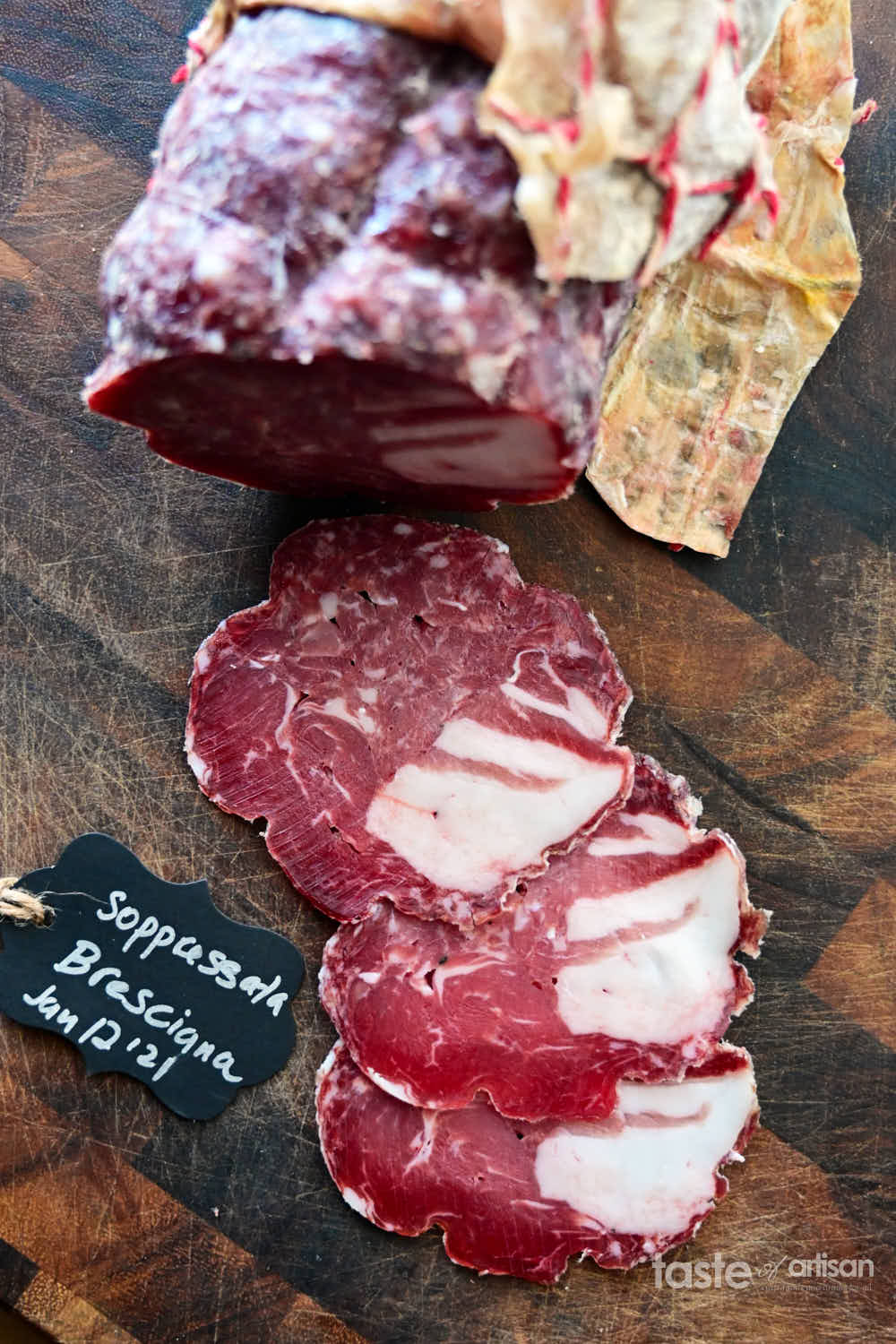
The typical weight of this sausage is between 3 and 5 pounds and the texture is relatively soft, especially when you first cut it. It will firm up a bit over time though.
The meat
A typical Soppressata Bresciana will contain about 2/3 of salami meat and 1/3 of whole meats, like pork tenderloin and pork belly. There is no hard rule here though. You can go add more of the salami mix if you wish or increase the ratio of pork tenderloin and/or pork belly.
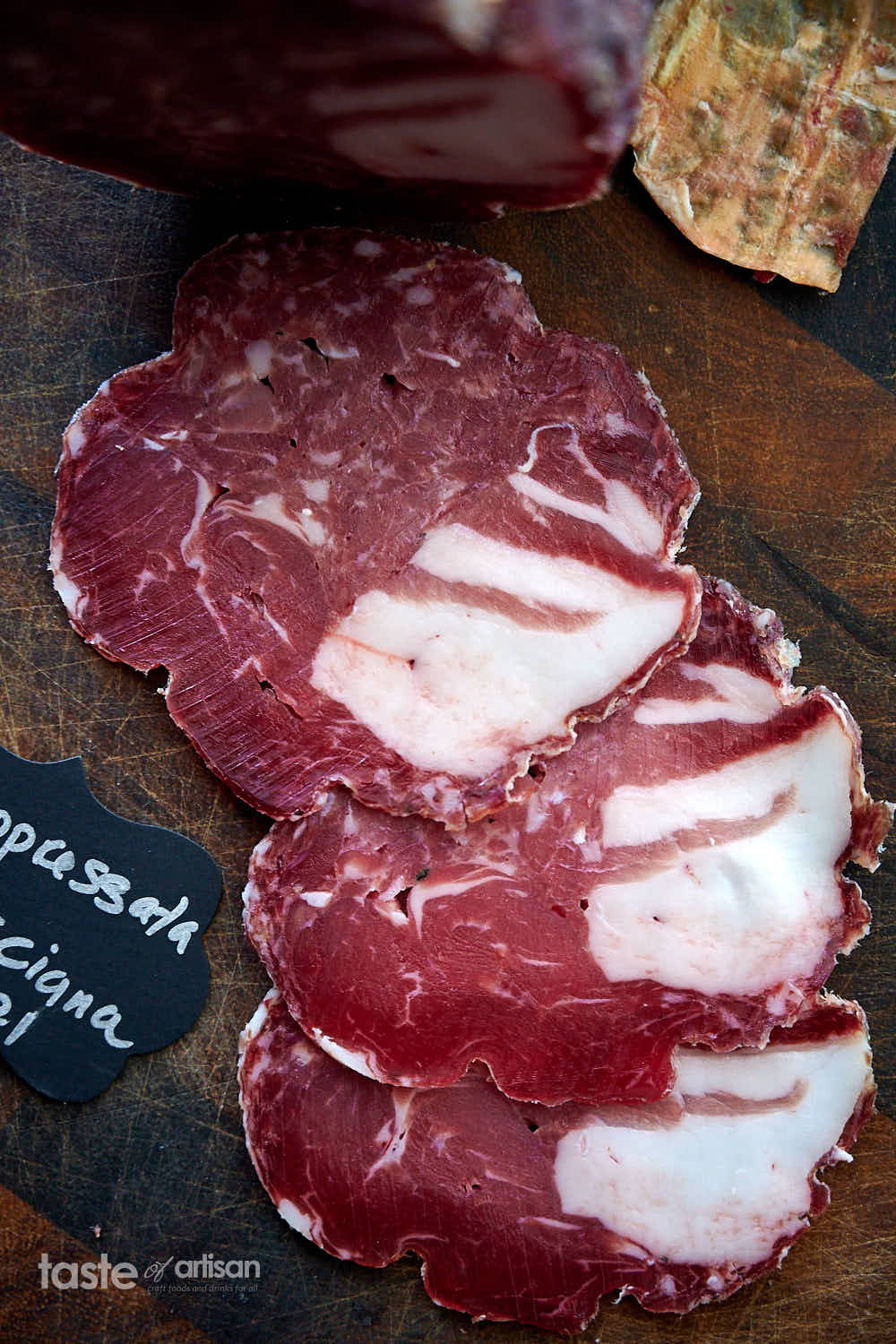
You can also vary the ratio of fat in the salami mix, anywhere from 15% to 30%. Traditionally, the salami mix in this sausage contains about 20% fat but I find it interesting to vary the ratios and see which one I like better - leaner or fattier. That's the beauty of making traditional Italian salami at home - you can make it any way you desire.
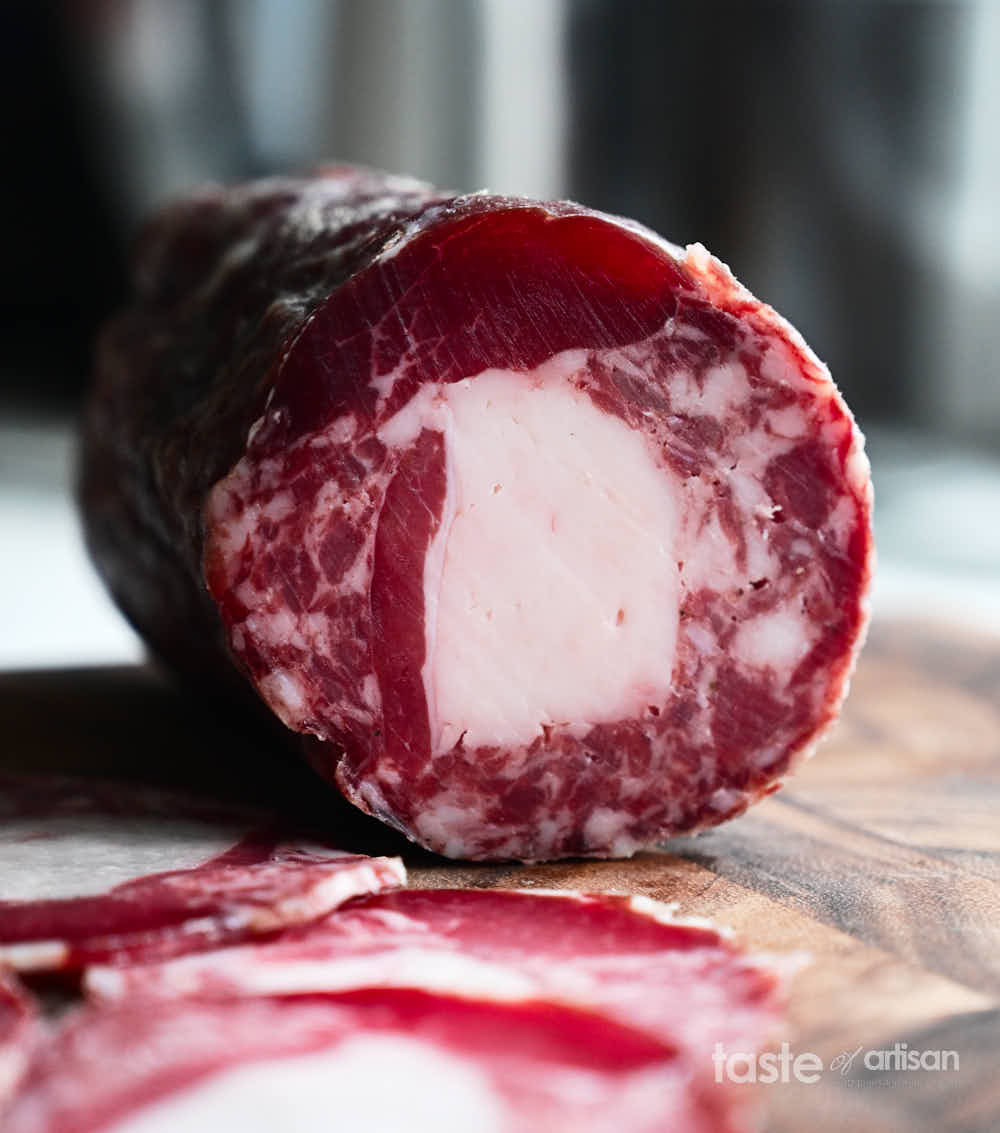
The seasonings
Traditionally, Soppresssata Bresciana is seasoned with black pepper, cinnamon, cloves, and nutmeg at 1.2 - 1.5 grams of seasonings per kilo of meat. In addition, you can add up to 50 ml of red wine per kilo of meat. The wine can be infused with crushed garlic at a ratio of about 1 garlic clove per 10 kilos of meat.
My recent experience with Italian PDO (protected designation of origin) recipes shows that some of these recipes are quite heavy on aromatic spices like cloves, cinnamon, and nutmeg. I find them somewhat overpowering. This sausage is a pleasant exception - there is plenty of aromatics in it but they are not over the top. I quite enjoy this sopressata and have made it twice over the past year.
And since I like the aroma of garlic, I use half a garlic clove per 1.5 kilos of meat in this recipe. It's barely detectable in the final product even with the increased amount of it.
Making Brescian Sopressata Salami
The first step is to cure the whole meat pieces before you stuff them. You don't need to cure the meat that you will grind, but you could if you want to. The meat is rubbed with salt and Cure #2 and refrigerated for 24 hours.
Once the meat is cured, grind the meat and the back fat for the salami mix. Add the seasonings and mix well.
Traditionally, this sopressata is stuffed manually. I've done it manually and using a sausage stuffer and prefer the sausage stuffer way. It allows for better compaction and fewer cavities in the final product.
Casings-wise, this sausage is traditionally stuffed into natural bovine casings, such as beef bungs.
First, fill in half of the salami mix. Add the whole pieces and then the rest of the salami mix. Massage the sausage to position the whole meat/pork belly pieces toward the center of the sausage.
If using a stuffer, stuff the casing very loosely with the ground meat, insert the whole pieces of meat/bacon, then insert the stuffing tube on the side opposite to the ground meat and stuff very tightly.
Next, tie the ends, expelling as much air as you can. Prickle with a sterilized needle and truss as tightly as you can. Trussing will help the sausage have a uniform thickness and expel any remaining air.
After that, the curing process begins - the sausage is fermented, dried, and cured/matured until about a 35% weight loss, about 3-4 months.
Taste notes
This sopressata salami is as unique in its appearance as it is tasty. It would be a perfect addition to any charcuterie board. I like the version with the slightly fattier salami mix, it makes the texture softer and creamier.
The aromatics are outstanding - noticeable but not overpowering.
The texture is what I probably like the most in this sausage - there is salami, lonzino, and pancetta all in one. This galore of textures is a clever complement to the complexity of aromatics.
Finally, it's worth mentioning that this sausage is considered soft, meaning it's not that easy to cut thinly with a knife. It firms up in the fridge over time but your best bet is to slice it with a slicer. I prefer to just slice the whole thing fairly thinly, vacuum seal, and refrigerate.
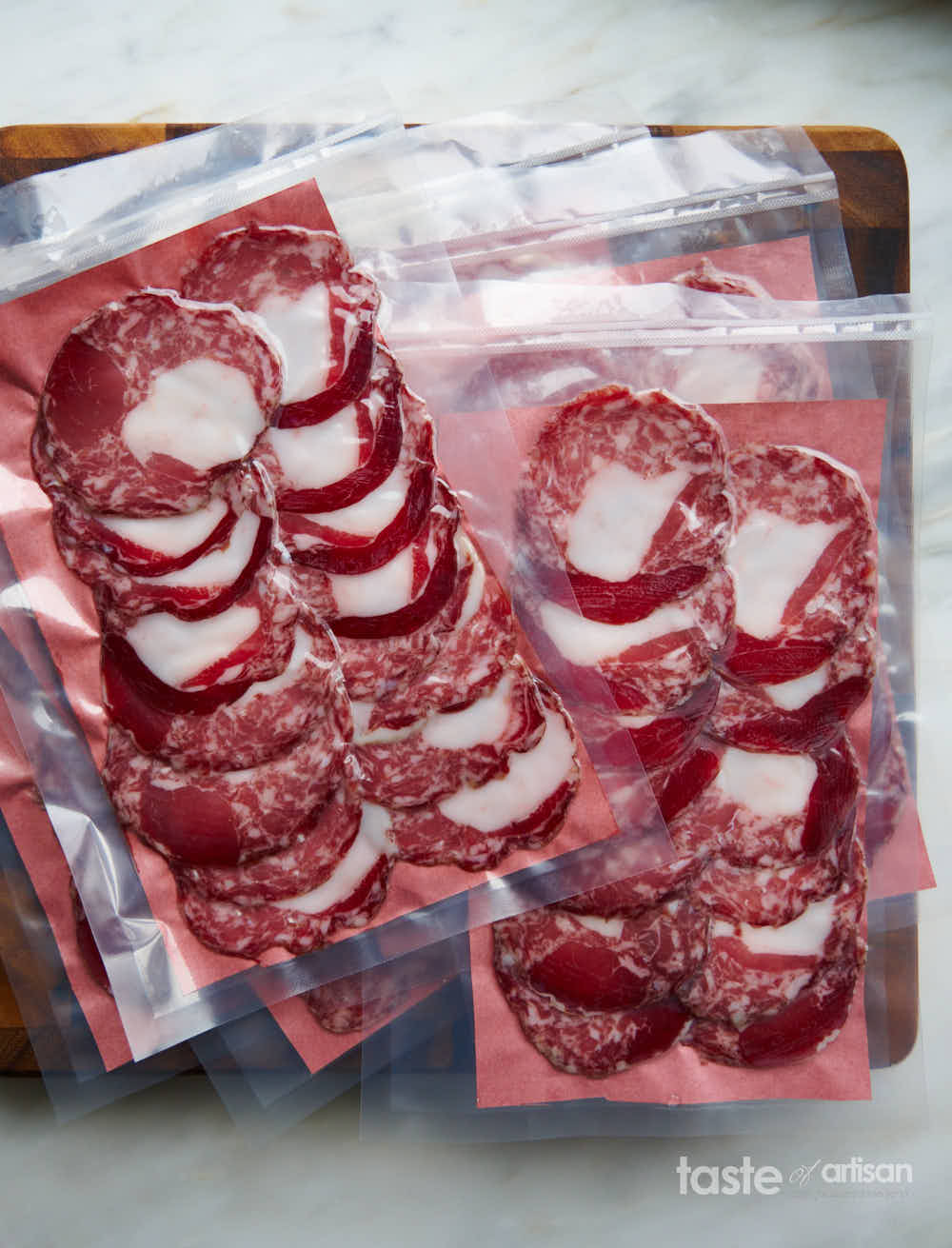
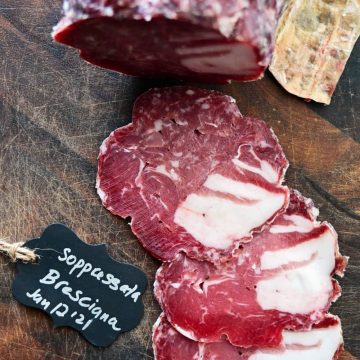
Sopressata Salami Made with Whole Tenderloin and Pork Belly
Print Pin RateIngredients
- 800 g lean pork any or a combination of lean ham, shoulder, neck (coppa), or loin
- 200 g pork back fat or fatty pork belly
- 250 g pork tenderloin whole (usually about 12" long and 1.5" thick)
- 250 g pork belly a 10-12" strip about 1.5" thick
- 38 g sea salt
- 4 g cure #2
- 1.5 g black pepper, cinnamon, cloves, nutmeg mix use either equal amounts or to taste
- 0.2 g T-SPX culture
- 2.5 g sugar
- 60 ml water
- 1/2 clove garlic crushed, for infusing wine only, removed after infusion
- 50 ml full-bodied red wine
Instructions
- Mix the salt and Cure #2 together. Weigh out 14 grams. Save the rest for later.
- Rub pork tenderloin and whole pork belly strip with 14 grams of the salt mixture, cover, and refrigerate for 24 hours.
- Crush the garlic and place it in a small cup. Add the wine and let it infuse for at least 30 minutes and up to 2 hours. Strain the wine before mixing it with the meat.
- Rehydrate the starter culture in 60 ml distilled water for about 30-60 minutes.
- Combine the remaining salt / Cure #2 mixture and sugar in a small bowl.
- Cut the lean meat and the back fat into 1-inch pieces and place into separate bowls. Sprinkle about 80% percent to the salt mixture over lean meat, 20% over fat and mix each well.
- Freeze the meat and the fat for 20 minutes before grinding.
- Grind the lean pork through a 3/8" (10 mm) grinder plate. Grind the fatty pork through a 3/16" (4.5mm) grinder plate.
- Combine the lean pork with seasonings, salt/Cure #2/dextrose mixture, wine, and starter culture. Mix well, until sticky, then mix in the groud back fat.
- Stuff half of the ground meat mixture very loosely into a 70-120mm natural casing. Insert the whole pork tenderloin and the bacon strip, positioning them however you prefer - center, side, together, or apart from each other. Next, stuff the rest of the ground meat very tightly and tie the end(s).
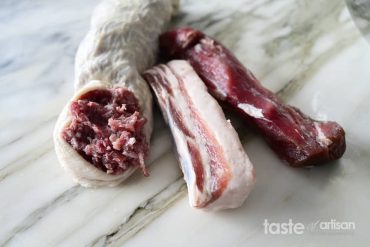
- Using a sterilized needle or sausage pricker, prick holes across the entire sopressata salami and truss tightly.
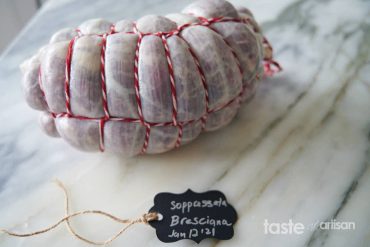
- Weigh the salami, write down its weight on a tag and attach the tag to the salami.
- If desired, inoculate with mold.
- Ferment and dry at 59F - 77F (15C - 25C) and 65% - 86% RH for a period of 7 days as per the schedule in the notes.
- The first step - dripping - can also be made in sous vide water bath set for 77F for about 4 hours to ensure that the meat warms up properly all the way to the center.
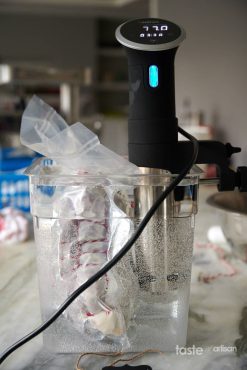
- Mature in the curing chamber at 55F - 57F (13C - 14C) and 78%-82% for about 3-6 months depending on the diameter of the sausage. Target weight loss is about 30%-35%.
Notes
| Stage | Duration | Temp | RH |
|---|---|---|---|
| Dripping | 14 hours | 77F (25C) | 95-99 % |
| Drying | 17 hours | 73F (23C) | 75-85 % |
| Drying | 24 hours | 71F (22C) | 68-78 % |
| Drying | 24 hours | 68F (20C) | 65-75 % |
| Drying | 24 hours | 64F (18C) | 68-78 % |
| Drying | 24 hours | 61F (16C) | 72-82 % |
| Drying | 24 hours | 59F (15C) | 76-86 % |
Nutrition


Tom says
Excellent recipe.
Anton says
Hello and greetings from Bulgaria 🙂
I have a question regarding the seven day drying period.
Where and how do you manage to maintain this high humidity and temperature before putting the sausage in the ripening chamber?
Thanks in advance !
Victor @ Taste of Artisan says
Hi Anton, welcome to my blog!
I do it in my curing chamber. You don't really need to do much to get high humidity. Just put the meat in the chamber (made from a fridge) and the humidity will shoot right up as the meat initially releases a lot of water, saturating the air with moisture. As the drying progresses, you need to drop the humidity, so you need a de-humidifier. Hope this helps. Good luck!
esb says
interesting but I don't understand how it's possible to stuff the rest of the ground meat very tightly using the stuffer. Well, I guess bungs only, which I've never used...
Victor @ Taste of Artisan says
You have to use a bung. When you stuff, wrap your thumb and index finger around the opening of the tube and hold it tight, letting the casing unravel under pressure. This will ensure a tight filling. Back in the day, there was no stuffers so this was done by hand with a spoon. Fill it as tight as you can, massage, fill more if needed, tie of the ends, prickle with a needle, then truss tightly with twine. That will get most, if not all, air out. Good luck.
Chris David says
Its really a nice recipe and mouth watering.